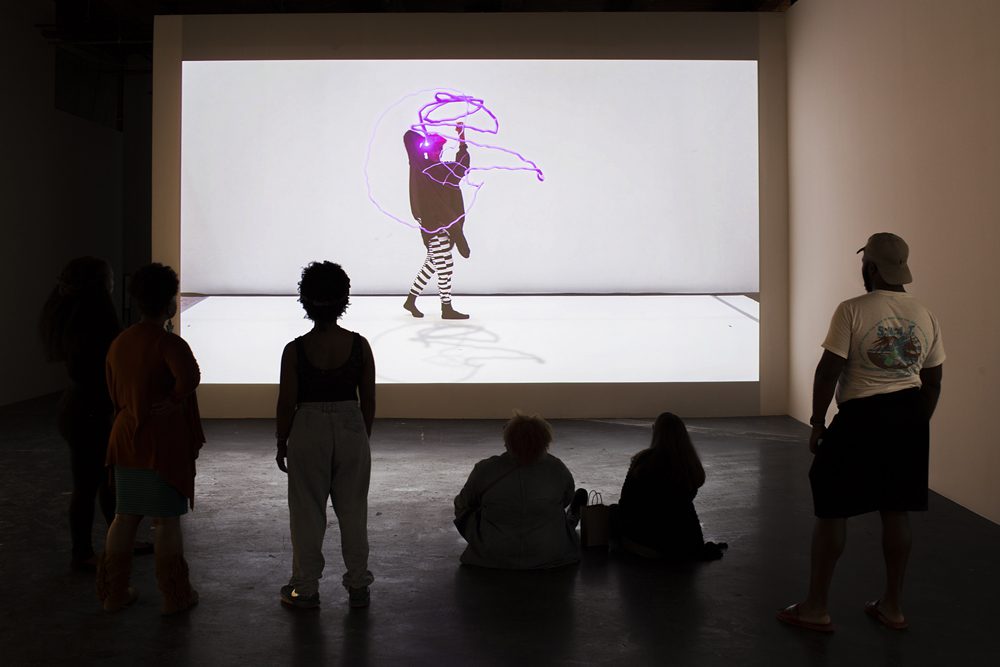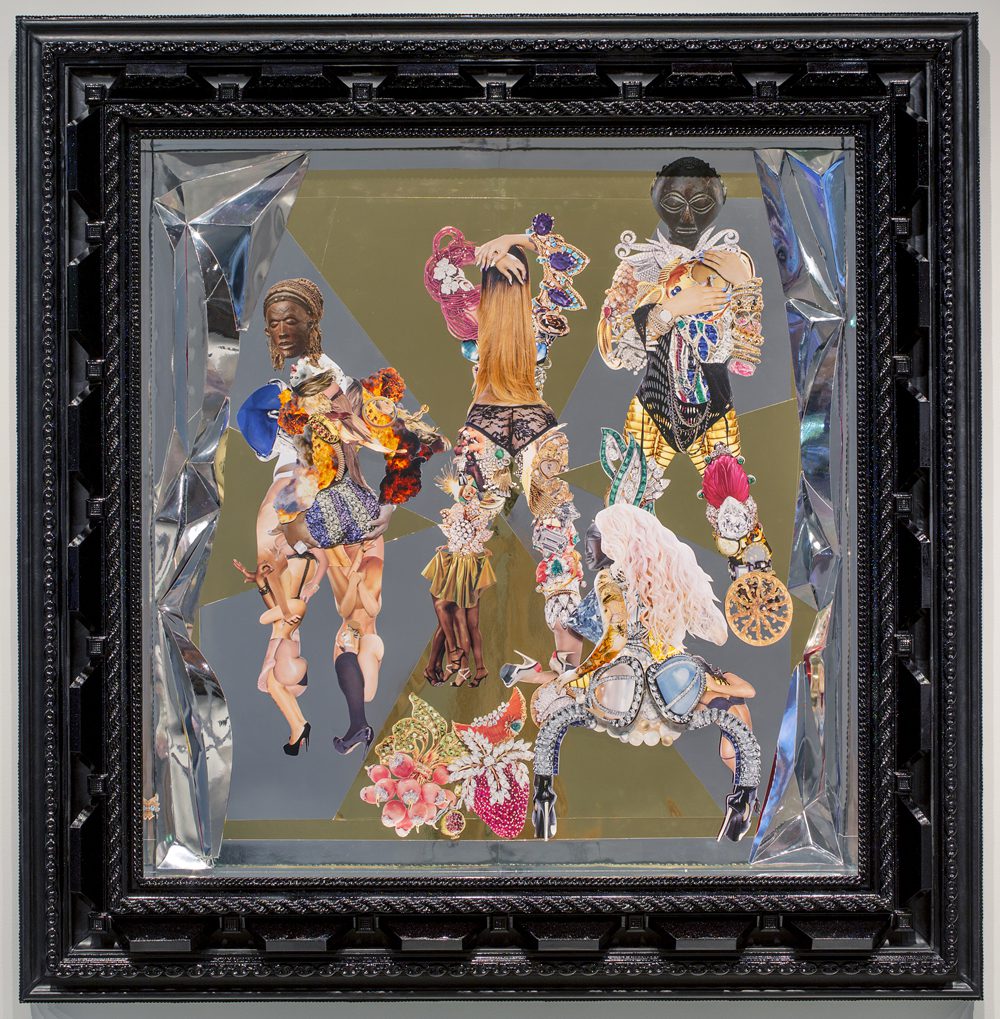Look Back at It: Rashaad Newsome at the Contemporary Arts Center
Allison Glenn reflects on visibility and performance in Rashaad Newsome’s recent exhibition at the Contemporary Arts Center.

Installation view of Rashaad Newsome’s “Mélange” at the Contemporary Arts Center, New Orleans. Photo by Alex Marks.
Rashaad Newsome’s multidisciplinary practice, on display in “Mélange,” the artist’s recent exhibition at the Contemporary Arts Center, often addresses absence through presence. From a distance, four colorful artworks in the back gallery appeared to be gestural abstractions. After a closer look, it was clear that the lithographs—which the artist created by mapping the movement of bodies in his FIVE SFMOMA performance video—included three-dimensional and photographic elements. Seeing these hybrid works on paper, coupled with the high-volume performance video, and another two-channel video at the end of the exhibition felt akin to a performance itself; this unveiling allowed the audience to simultaneously access Newsome’s process and his broader conceptual strokes.
Within Newsome’s larger oeuvre, ideas and concepts coalesce around the reconfiguration of material culture. The artist samples from a wide range of influences that center on the body, including art history, language, and print media. As Newsome states in the exhibition brochure, “I’m interested in turning movement into material, and material into movement again.” On the opening day of “Mélange,” the artist gave a walk-through of the show where he explained why he uses imagery and advertisements from popular magazines within his collage works. For Newsome, this is a way to critique and raise awareness of the lack of representation of black and brown non-cisgender people and bodies in popular media.
At the Contemporary Arts Center, the artist’s signature Baroque-inspired custom frames ensconced the collage works that lined the walls of the first-floor galleries. The frames’ all-black candy paint refers to car culture. Collage works with names like Red Bone, 2016, and Girl Bye, 2016, were created with glossy appropriated photographs intricately fused together onto stark black surfaces. The artist’s manipulation and reconfiguration fractures the surface of these widely circulating images. A delicate oscillation between figuration and abstraction is exemplified in Look Back at It, 2016, a significantly large composition with an undulating, reflective ground. A clever play on words, the figures in Look Back at It actively return the viewer’s gaze. A response to Picasso’s Les Demoiselles d'Avignon, 1907, Newsome’s collage technique in Look Back at It is a revisionist narrative that shifts the colonialist dynamics inherent in Picasso’s painting.

Rashaad Newsome, Look Back at It, 2016. Mixed media. Courtesy the artist. Photo by Alex Marks.
The dominance of the cisgender gaze and the desire to shift narratives away from binary formations of gender (male/female) and sexuality (straight/gay) have recently gained greater attention in the discourse around contemporary art. And although a feedback loop has existed between vogue and pop culture for over 20 years, some critics question the presence of voguing in the mainstream, arguing against the appropriation and co-option of what is, for many, a sacred tradition.
During “Mélange,” Newsome produced a version of FIVE for New Orleans—the artist’s home town. These back-to-back, sold-out performances were dedicated to the legacy of Barack and Michelle Obama. On the otherwise terribly melancholic Inauguration Day for the 45th President of the United States of America, the celebration of queerness and blackness underscored the radicalism of visibility. While stunning in depth, form, and execution alone, FIVE conceptually articulates the absence/presence binary that Newsome’s work so cleverly deconstructs: The power of being aggressively present rebukes consistent attempts at erasure. And through the use of time-based media, Newsome challenges these binary positions and ignites a conversation around the limits of language used to describe ourselves and others.
Throughout the performance, Newsome was positioned at the front of the stage operating a laptop with motion-tracking software and an X-box with a Kinect camera. The dazzlingly captivating and highly charged durational performances consisted of five vogue dancers, three live musicians, an opera singer, and two emcees. Each vogue dancer’s hair, nails, and makeup were selectively color coordinated. Blue, green, pink, yellow, and red were assigned to their bodies representing the five elements of Vogue Fem: hands, catwalk, floor performance, duckwalk, and spin dips. As each vogue performer entered the arena of the stage, one singer sang scat-like directions for the dancers to quickly interpret. Bodies flipped, dipped, turned, dropped, and gyrated on the beat until an emcee signaled it was time for them to exit almost as quickly as they arrived. But not before giving good face.
Editor's Note
Rashaad Newsome’s “Mélange” was on view January 14 - February 12, 2017, at the Contemporary Arts Center (900 Camp Street) in New Orleans.



